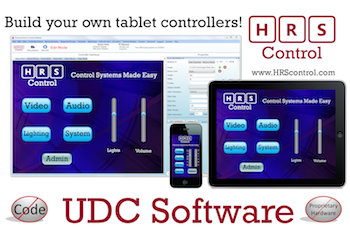High Resolution Systems will be showcasing a number of new features for its UDC (Universal Device Controller) software at InfoComm12, Booth N668.
- The innovations include new user interface options, Windows 8 and Apple iOS apps, and a renewed dedication to the concept of open systems for maximum client flexibility.
- “It’s our goal to support any tablet or smart phone – to leave the options wide open for our customers to use any hardware they choose as their control platform,” said High Resolution’s Drew Taylor. “We’re big advocates of giving the customer the flexibility to get really creative about how they integrate hardware.”
- With that in mind, High Resolution Systems supports the Bring Your Own Devices (BYOD) trend, which finds customers using Apple iPads, iPhones, iPod Touches, Android and Windows tablets and smart phones for PRO AV control depending on venue and convenience factors. The introduction of UDC Controller Groups now enables customers to build multiple versions of the same page in their control system, specify them as a controller group and have different resolutions and aspect ratios automatically available for a range of control devices as needed.
- This new feature for UDC comes on the heels of the debut of a Windows 8 client controller app, available from High Resolution Systems, for an extended feature set on Windows-enabled devices.
- A new dedicated iOS app, HRS Control Pro, for extended control from all versions of iPhone, iPad and the iPod Touch in landscape and portrait modes, has just become available in the Apple App Store.
- Both the Windows 8 and Apple iOS client apps offer the ability to download different UDC configurations and store them for offline viewing. “This allows customers to use them in a demo mode; it’s a very useful sales tool that allows our customers to take their control systems projects anywhere they go and have ready for demonstration,” Taylor said.
- At NAB, the company introduced new UDC variables, logic and slider features, which work with existing UDC macros to provide very powerful options for configuring UDC control systems. Customer requests for sliders prompted High Resolution Systems to roll them out for the entire UDC user base. A slider is typically used for volume and lighting control and is one more step for us beyond simple button based control.
- Variables and logic work together when customers need to execute complex strings of commands. Buttons set the variable, which is typically a value for recalling a preset or control for a device such as volume level. Another button will send the command using the current value of the variable. UDC Logic enables the user to compare variables and extend them further, sending commands to apply variables simultaneously across the board in advanced executions.
- At InfoComm, toggle switches and lists have been added to user interface design options. Toggle switches offer simple on/off functionality. Customers may now also build their own custom lists and define the display name and value of each item control Pro Av equipment. In addition, they can create lists of from supported devices, such as image processors and media servers, and execute the functionality – to play clips or pre-sets, for example – tied to those devices. The new lists also work on UDC’s web-server feature and Windows 8 and iOS apps.










